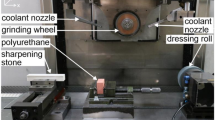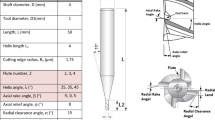Abstract
The attempt has been made to determine the grinding direction and the wheel translation which produce the best microsharpness for carbide-tipped tools, such as carbide-tipped saws. Other grinding variables considered were rake angle, grinding depths and diamond-grit size. The results suggest that the grinding direction should be adjusted to an angle of 45° or larger to the cutting edge and that the grinding wheel may be fed parallel to the plane of grinding, but should always be retracted perpendicular to it. Grinding direction in grinding the first face was found not to influence the microsharpness of the cutting edge.
Zusammenfassung
Es wurde der Versuch unternommen, die Schleifrichtung und diejenige Schleifscheibenbewegung beim Schleifen von hartmetallbestückten Werkzeugen zu bestimmen, welche die beste Mikroschärfe ergibt. An weiteren Einflußgrößen wurden der Spanwinkel des Werkzeuges, die Schleiftiefe und die Größe der Diamantkörnung untersucht. Die Resultate zeigen, daß man die beste Mikroschärfe erhält, wenn die Schleifrichtung mit der Werkzeugschneidkante einen Winkel von 45° oder größer bildet, und wenn die Führungsbahn während des Schleifhubes parallel, während des Rückhubes aber senkrecht zur Schleifebene liegt. Die Schleifrichtung beeinflußt die Mikroschärfe aber nur beim Schleifen der Schneidenbrust.
Similar content being viewed by others
Literature
Danielsen, B.S. 1966: Investigation of methods for grinding TCT tools. Woodworking Industry 23(11):22–24
Fischer, R.; Tröger, J.; Herath, M. 1977: Untersuchung zum Einfluß von Gestaltfehlern rotierender Holzbearbeitungswerkzeuge auf Verschleiß und Qualität. Holztechnologie 18(4): 224–231
Kirbach, E. 1975: Unpublished results of an investigation on the wear of cemented carbide tips. Forintek Canada Corp., West. Lab., Vancouver, B. C.
Kirbach, E.; Bonac, T. 1979: Minimum clearance angle required for rip-sawing some softwoods. Proceed. Sixth Wood Mach. Seminar, Forest Prod. Lab., Richmond, Calif. (in press).
McKenzie, W.M.; Karpovich, H. 1973: Some factors affecting wear and blunting of a tool corner. Proceed. IUFRO Group 5 Meetings, South Africa. p. 732–741
Miller, H.C. 1979: Relationships of diamond wheel performance to wheel composition, work characteristics and operating parameters. Cutting Tool Engineering. 31(5/6): 69–70
Author information
Authors and Affiliations
Rights and permissions
About this article
Cite this article
Kirbach, E.D., Bonac, T. Influence of grinding direction and wheel translation on microsharpness of cemented tungsten-carbide tips. Holz als Roh-und Werkstoff 39, 265–270 (1981). https://doi.org/10.1007/BF02614455
Issue Date:
DOI: https://doi.org/10.1007/BF02614455




